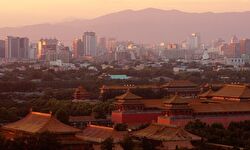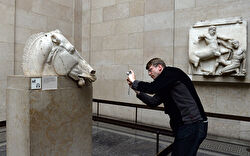
Romania may not be the envy of the European Union for many things, but in one it should be: the mountains of Carpathia house the last great wilderness of this prosperous, crowded continent.
Fly over the mountains in a helicopter and the scale is breathtaking — mile after mile of precipitous tree-covered slopes, home to bears, wolves and wildcats. The range is 900 miles long, of which more than 12,000 square miles are considered “high-value conservation areas”. Some of the trees are 700 years old, sprouting from the ground since the battle of Bannockburn. Walk through the arboreal gloaming — where the air is pungent, the ground is strewn with fallen branches or thick with dried needles and leaves, and feldspar pebbles glitter silver in the streams — and you feel reconnected with some primeval sense of how the continent was before the Habsburgs and Napoleon, before even Greece and Rome. Yet, shockingly, this natural wilderness is being plundered.
It is not what freedom from communism promised. When Nicolae Ceausescu, the thick-pated Stalinist who ruled Romania from 1965 to 1989, was dragged before a kangaroo court and then shot by firing squad on Christmas Day 1989, it seemed dramatic evidence that totalitarianism was finished in eastern Europe.
Like many dictators, Ceausescu had a soft spot for those parts of his country he had not vandalised. It was an idiosyncratic affection, admittedly: he liked to kill things there.
(Since he was a terrible shot, the unfortunate bears, wolves and other animals whose trophy heads hung on his walls had usually been lured into his sights with bait, or had been dispatched by one of his entourage with a sniper rifle.)
When the dictator himself was dispatched, the new government of free Romania set about restoring the ancient forests to those who could prove they owned them before the communists seized power. This was often easier said than done. While forests are embedded deep in the Romanians’ sense of themselves, the Carpathian Mountains marked the boundary between Transylvania and Wallachia, which held very different concepts of “ownership” in the Austro-Hungarian and Ottoman empires. It took years but, by the early 21st century, restitution was under way.
Local farmers and others now found themselves the owners of tracts of forest. So far, so good. But this is a story about capitalism and its consequences — good and bad, intended and unintended. For with ownership came liability for land taxes and for dues payable to the forestry authorities. These turned a restored asset into a liability.
“Peasant” is not a word much used in 21st-century Europe. But it is the correct description for many of the communities that now found themselves proprietors of great expanses of forest. Even today, the hay is cut by hand and pitchforked on to horse-drawn wagons. Local farmers who had lived in and among the forests for generations knew that, once you got beyond the areas cleared for pasture, the only money to be had to pay their taxes was from the timber of the trees.
Suddenly, salvation appeared, in the shape of lumber companies from the more prosperous parts of Europe, notably Austria. By selling logging rights to the incomers, the new owners turned a liability into cash. This seemed like the end of the problem — but the logging companies practised a new, industrial style of harvesting.
In the bad old days, while Romania was poor, it was at least self-sufficient in timber. Freedom from communism gave access to a vast new market desperate for the ersatz Scandinavian wooden furniture that was the mark of the prosperous young European.
The foreign industrialists chopped down absolutely everything in a practice known as “clear-cutting”. Any objections could be settled by greasing a few palms. If the new loggers replaced the felled trees at all, they generally did so with spruce, turning a glorious jumble of ash, sycamore, elm, rowan and evergreens into dreary, acid-soiled monoculture.
Between 2009 and 2011, more than 30,000 cases of illegal logging were registered by the authorities. The following year, Greenpeace estimated that almost two square miles of forest were disappearing in Romania every week. There were soon ugly patches in the wilderness where all that was left were stumps and dead brushwood. Tracks that were cut to allow tractors to drag out the timber turned into watercourses the moment it rained, washing away topsoil and cutting crevasses, some of which were almost five metres deep. The bears, wolves, lynx, chamois and red deer retreated.
The history of the European continent is one of relentless exploitation of the land: civilisations have risen and fallen, leaving their mark in how they tamed the world. In the elegant explanation of the historian Sir Keith Thomas, “uncultivated land meant uncultivated men”.
In domesticated Britain, William Gladstone’s well-known enthusiasm for chopping down trees was a mark of his commitment to civilisation. The fact that the British press is regularly engorged by tales of mysterious “Beasts” prowling the edges of the suburbs is testament to the fact that the country has had no indigenous big carnivores for centuries. The British prefer their outdoors to be tamed and picturesque — and scattered with that walking waste-disposal unit, the sheep.
A different sense of wilderness took hold across the Atlantic, where in 1845 the 27-year-old Henry David Thoreau built himself a one-room log cabin in Massachusetts. His account of his simple life there, Walden, soon acquired semi-religious status.
There was enough variety in Thoreau’s beliefs — transcendentalist, tax refusenik, abolitionist, civil disobeyer — to comfort anyone from Mahatma Gandhi to the local survivalist chapter.
But what struck a chord with almost everyone was his talk of the “tonic of wildness”. In 1864, President Lincoln signed the first order creating a protected wilderness, in Yosemite, California. The patron saint of the American conservation movement, the Scots-American John Muir, wrote: “Thousands of tired, nerve-shaken, over-civilised people are beginning to find out that going to the mountains is going home; that wildness is a necessity.”
What is known in Britain as wilderness (mainly the Scottish Highlands) is anything but — almost all the forests having been cleared centuries ago: what we really mean is “sparsely populated”. There was much greater scope for embracing nature in the New World, and Muir illuminated the central contradiction of a society built upon the persistent expansion of the area considered “civilised” (the conquest of the Wild West) and nourished by the frontiersman myths of characters such as Daniel Boone and Davy Crockett.
The simplest definition of a wilderness is that it is an area controlled by natural processes. Respect for wilderness is therefore the antithesis of the human impulse to impose order. Command of nature is intrinsic to state communism, with its five-year plans and exhortations to Stakhanovite work rates. In the United States, it was some of those made richest by the taming of nature, such as John D Rockefeller, who soon began to devote their fortunes to preserving it.
Their contemporary equivalents are the entrepreneur couple Doug and Kris Tompkins, who have so far bought two million acres of land in Argentina and Chile. Their intention is to create vast national parks there, including the Parque Patagonia. (Scale is essential for natural processes to reassert themselves.) Doug made his fortune from establishing the North Face and Esprit brands, until deciding that he was encouraging needless consumption by “simply producing stuff that no one really needed”. His wife Kris ran the Patagonia label.
It is hard to imagine a more open, windswept environment than Patagonia: you really do feel you’re at the end of the world. It’s probably because you are.
Condors soared above me as I drove the dirt road south on a recent visit. The hillsides around the lodge the Tompkinses have built in southern Chile are alive with guanacos, bad-tempered-looking llama-like animals that have flourished in the protected environment the couple have created.
There is no doubting the Tompkinses’ zeal. Doug talks of the vanity of “civilisation” if the planet on which it is achieved is effectively dead. This is faintly reminiscent of Robbie Burns’s worry for the “wee, sleekit, cow’rin, tim’rous beastie” of a mouse, whose nest the plough destroyed. But is the controversial sequitur that social justice must take second place to the protection of nature?
The couple have previously admitted their convictions are “religious”, and the gangs of young volunteers who make their way by thumb or bicycle down the dirt roads to reach the Parque Patagonia are dedicated disciples. At mealtimes the restaurant is a bit like the refectory of an American college: the volunteers have that sheen-and-T-shirt look of paid-up believers in the gospel of the environment (even if they cannot live without their iPhones and MacBooks). These bien pensant environmentalists have been prominent in campaigns to stop the building of dams in Patagonia to provide hydroelectric power, much to the fury of those who say that Chile needs clean energy.
When I checked the other day, I was unable to find a single Chilean sitting on the board of the Parque Patagonia. The Parque says that the process of handing over the place to the Chilean people will begin soon — maybe even this year, but that a full transfer could take another decade. It’s complicated.
Any foreigner acquiring land abroad has to cope with nationalist resentment — as Englishmen discover when they buy estates in the Scottish Highlands and find themselves blamed for everything from the Clearances to the inadequacy of broadband. North Face and Patagonia are international brands, headquartered in one part of the globe, manufacturing in another and selling their products in all places in between. Of course their founders see the world in post-nationalist terms.
Cui bono? — who benefits? — is the investigators’ question. The Bible tells us that Jesus withdrew into a wilderness so that he could be tempted by the devil. Can there be anything malevolent about rich people indulging their passion by securing a wilderness? Does anyone see the irony in a bunch of foreigners running a project to protect the huemul deer, Chile’s national animal, which had become so rare that some Latin Americans had begun to doubt whether it existed at all?
The only point in having money is, presumably, to do something with it. Rich people might just as easily blow their fortunes on yachts, mansions in Monte Carlo, blasting themselves into space or freezing their corpses.
Preserving the environment for future generations is a lot more worthwhile than most of the alternatives. The wild parts of Romania represent just about the last opportunity for large-scale conservation in Europe.
As it happened, in 1993, a few years before the plunder there reached its height, a 28-year-old German had arrived in the Carpathians. Christoph Promberger went there to study wolves. He had no money but had managed to persuade a natural history institute in Munich to sponsor him and the outdoor clothing brand Jack Wolfskin to clothe him. With a stable footing, he extended his project to become a study of all large carnivores in the Carpathians.
Soon he was joined by other eager young biologists, including Barbara Fuerpass, an Austrian student volunteer. They fell in love and married. When restitution took place, the couple realised that their research would be utterly pointless if the habitat that supported the bears, wolves and wildcats vanished. They committed themselves to doing whatever they could to stop the wrecking of the wilderness. “This is the last place in Europe where all wildlife and forest components are present,” says Promberger. “Walking through these forests makes you understand your place in nature and it has become my purpose in life to safeguard them from the greedy timber mafia.”
Where to turn for help? Unlike every other European Union country, the government of Romania had no national budget for protected areas. It had also developed Europe’s grisliest culture of corruption, where any problem could be settled with a backhander or two. (This situation is getting better — last year, 24 mayors, five members of parliament and seven judges, along with more than 1,000 others, were convicted on corruption charges.) Even when ministers were clean, they changed offices bewilderingly often: in 2014 there were no fewer than three politicians in charge of conservation policy. Meanwhile the European Union would happily dispense money to encourage grazing and to build logging roads.
But was it possible that, having caused the problem, capitalism might also come to the rescue? The correct definition of “disinterested” is to be free from self-seeking. Perhaps that possibility is open only to those wealthy enough not to worry, many of whom certainly lead supranational lives. Christoph and Barbara found a sympathetic ear in Hansjörg Wyss, a Swiss-American who had made a fortune producing medical devices. He gave nearly €25m to buy up stretches of Romanian forest, encourage conservation and promote eco-tourism. When asked why, he says simply that, “we have a shared responsibility to protect the last wild places in the world”. Other donors have followed but they have the feel of pioneers: “wildlands philanthropy” has yet to put down deep roots in Europe.
In the meantime, the logging companies continue to fell the trees. The Fundatia Conservation Carpathia, founded by Barbara and Christoph, hopes for more philanthropists, nursing an ambition to create in Romania “a Yellowstone or Serengeti for Europe”, in the words of a British supporter, Paul Lister. One day, they dream, the country might become the Costa Rica of Europe.
. . .
Each year, humankind destroys more of our planet — for survival, profit or to justify political claims. The arguments for plundering a wilderness can be much more easily made than the arguments against doing so.
Why, in short, should the people who live in these areas be kept poorer than they need be?
Wildlands philanthropy is a particularly American idea, rooted in traditions of free enterprise. For numerous reasons — longevity of settlement and density of population being the obvious ones — there are many fewer wild places to protect in Europe than in the Americas. No one wants to stop people having chairs and tables and beds. But we have to find a more sensible way of supplying timber than by laying waste a unique environment such as the Carpathians. To see the last great wilderness of Europe destroyed is to impoverish all of us. It deprives us of something that tells us who we are.
By building filthy factories, communism did much to ruin Romania. But the scythes and ancient conical haystacks, the shepherds still living in mountain clearings for months on end, show how little impact those few decades of modernism had. A few decades of capitalism could be something else. Will the price of political freedom be the end of environmental freedom? If even a bonehead like Ceausescu could appreciate the importance of wilderness, anyone can.
Article courtesy of the FT Magazine. Original found here.



